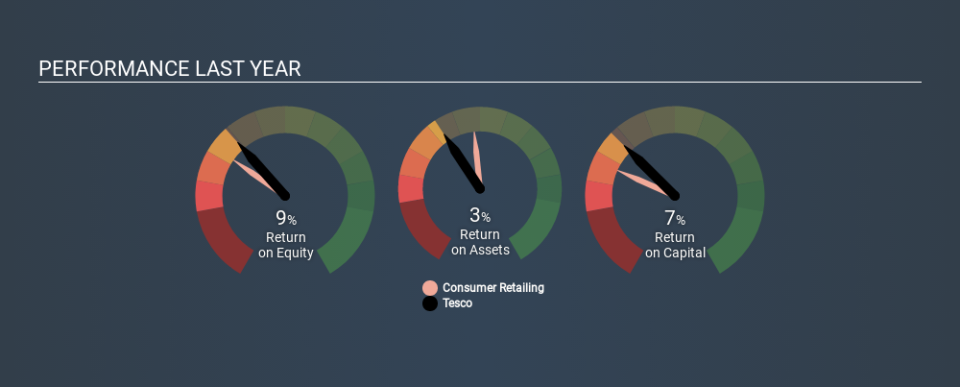Do Tesco PLC’s (LON:TSCO) Returns On Capital Employed Make The Cut?

Today we are going to look at Tesco PLC (LON:TSCO) to see whether it might be an attractive investment prospect. To be precise, we'll consider its Return On Capital Employed (ROCE), as that will inform our view of the quality of the business.
First up, we'll look at what ROCE is and how we calculate it. Second, we'll look at its ROCE compared to similar companies. Last but not least, we'll look at what impact its current liabilities have on its ROCE.
Understanding Return On Capital Employed (ROCE)
ROCE measures the amount of pre-tax profits a company can generate from the capital employed in its business. In general, businesses with a higher ROCE are usually better quality. Ultimately, it is a useful but imperfect metric. Author Edwin Whiting says to be careful when comparing the ROCE of different businesses, since 'No two businesses are exactly alike.
So, How Do We Calculate ROCE?
Analysts use this formula to calculate return on capital employed:
Return on Capital Employed = Earnings Before Interest and Tax (EBIT) ÷ (Total Assets - Current Liabilities)
Or for Tesco:
0.066 = UK£2.4b ÷ (UK£57b - UK£21b) (Based on the trailing twelve months to August 2019.)
So, Tesco has an ROCE of 6.6%.
See our latest analysis for Tesco
Does Tesco Have A Good ROCE?
When making comparisons between similar businesses, investors may find ROCE useful. We can see Tesco's ROCE is around the 6.7% average reported by the Consumer Retailing industry. Separate from how Tesco stacks up against its industry, its ROCE in absolute terms is mediocre; relative to the returns on government bonds. Readers may find more attractive investment prospects elsewhere.
We can see that, Tesco currently has an ROCE of 6.6% compared to its ROCE 3 years ago, which was 4.1%. This makes us wonder if the company is improving. You can click on the image below to see (in greater detail) how Tesco's past growth compares to other companies.
It is important to remember that ROCE shows past performance, and is not necessarily predictive. ROCE can be deceptive for cyclical businesses, as returns can look incredible in boom times, and terribly low in downturns. This is because ROCE only looks at one year, instead of considering returns across a whole cycle. Since the future is so important for investors, you should check out our free report on analyst forecasts for Tesco.
Tesco's Current Liabilities And Their Impact On Its ROCE
Short term (or current) liabilities, are things like supplier invoices, overdrafts, or tax bills that need to be paid within 12 months. The ROCE equation subtracts current liabilities from capital employed, so a company with a lot of current liabilities appears to have less capital employed, and a higher ROCE than otherwise. To counter this, investors can check if a company has high current liabilities relative to total assets.
Tesco has current liabilities of UK£21b and total assets of UK£57b. As a result, its current liabilities are equal to approximately 36% of its total assets. Tesco has a medium level of current liabilities, which would boost its ROCE somewhat.
The Bottom Line On Tesco's ROCE
Unfortunately, its ROCE is still uninspiring, and there are potentially more attractive prospects out there. But note: make sure you look for a great company, not just the first idea you come across. So take a peek at this free list of interesting companies with strong recent earnings growth (and a P/E ratio below 20).
I will like Tesco better if I see some big insider buys. While we wait, check out this free list of growing companies with considerable, recent, insider buying.
If you spot an error that warrants correction, please contact the editor at editorial-team@simplywallst.com. This article by Simply Wall St is general in nature. It does not constitute a recommendation to buy or sell any stock, and does not take account of your objectives, or your financial situation. Simply Wall St has no position in the stocks mentioned.
We aim to bring you long-term focused research analysis driven by fundamental data. Note that our analysis may not factor in the latest price-sensitive company announcements or qualitative material. Thank you for reading.

 Yahoo Finance
Yahoo Finance 
